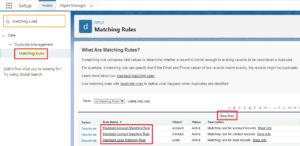Hello Trailblazers!
In the area of Salesforce data management, ensuring data accuracy and integrity is paramount. One of the critical aspects of maintaining clean data is identifying and merging duplicate records efficiently. This is where Matching Rules come into play.
In this blog, we’ll learn Matching Rules in Salesforce, exploring their significance and implementation.
So let’s get started!
What is Matching Rules?
Matching Rules in Salesforce are a set of criteria used to identify duplicate records within a dataset. These rules define the conditions under which two records are considered a match, enabling Salesforce to detect potential duplicates.
For instance, a Matching Rule might dictate that if the Email and Phone values of two records are identical, they could be considered duplicates.
Matching Rules are crucial for maintaining data quality, enhancing user productivity, and ensuring a unified view of customer information.
How to Create Matching Rules?
Here we’ll create a matching rule on the Employee object to ensure that duplicate employee records should not created.
So to create the Matching rule, follow the below steps:
- Go to the Setup.
- Enter Matching Rules in the Quick Find box.
- Click Matching Rules under Duplicate Management.
- It’ll take you to the Matching Rules page where Standard Matching rules for Account, Contact, and Lead Objects are already created as shown in the figure below.

- Click New Rule as shown above.
- Select the desired object on which you have to create matching rules. So here I selected the “Employee” object.
- Give the Rule name. Unique Name will automatically be populated.
- Inside the Matching Criteria, Field = Email and Matching Method = Exact. See the figure below.

Note: If you check the Match Blank Fields box in front of the Email field, so it will compare the 2 blank email fields, consider them matching and eventually will give the duplicate error. - Click Save.
- Click Activate.

So with this, we created the matching rule and by activating it, it’ll be available to use in the Duplicate rule.
Conclusion:
Matching Rules in Salesforce are a vital tool for maintaining data quality and ensuring a unified view of customer information. By defining clear criteria, choosing appropriate matching methods, and following best practices, organizations can effectively identify and merge duplicate records, leading to improved decision-making, enhanced user productivity, and increased customer satisfaction.
Happy Reading!!
References:
You Can Also Read:
- An Introduction to Salesforce CPQ
- Salesforce CPQ and its Key Features
- Unlocking the Power of AI: Einstein for Developers
- Revolutionizing Customer Engagement: The Salesforce Einstein Chatbot





Thank you for this post.